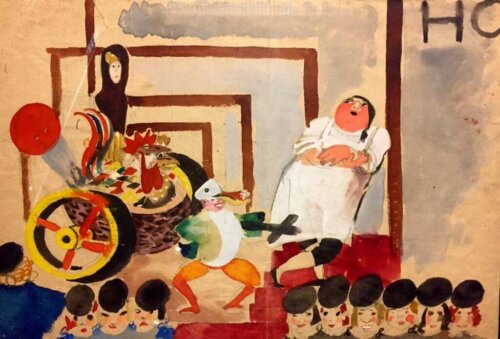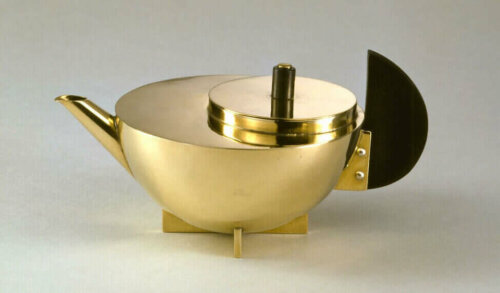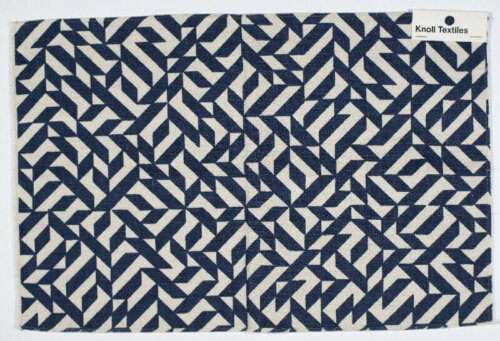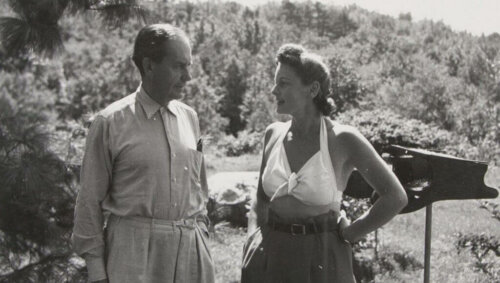The Forgotten Architects and Designers of the Bauhaus

The Bauhaus was an important school of architecture and applied arts. One hundred years after its foundation, many people have forgotten about the great architects and designers of the Bauhaus. We’re going to take a look at a few! These women had an artistic vocation. Many of them enrolled because they were attracted to the most progressive educational center of the time.
However, while the brochures advertised promises of equality, this was not the attitude inside the school. The teaching staff contributed to many female student’s invisibility. They also caused the lack of public recognition of their work.
For example, many people have written about the great artists of the Bauhaus, such as Lázló Moholy-Nagy, Mies van der Roje, Paul Klee, or Wassily Kandinsky. However, on the other hand, very little has been written about the work of the women who also studied and created there. Many of them are only remembered as wives.
The Bauhaus artists were modern. As a result of their way of life, they broke with the traditional role of women during those years. For example, they cut their hair short, wore long pants, and went to cabarets. They also listened to jazz and owned their sexuality.
Often known as “flappers,” these women were a prototype of modern women. Many young German women idolized this prototype. The American silent cinema brought this idea to Germany. Also, World War I led to women leaving the home to work. Many men left important jobs behind when they went off to war. Through these jobs, women had access to new spheres.
As a result, we want to recognize the work of these women and their contributions to avant-garde designs and architecture. We’re going to look at a few examples.
The Forgotten Architects and Designers of the Bauhaus – Friedl Dicker

Friedl Dicker was one of the first female students to enroll in the Bauhaus. She also was perhaps one of the brightest students to go to the school. With other students, such as Franz Singer, Anny Wottitz, and Margit Tery, Dicker became part of the well-known group “The Viennese.” They were a group of students who came from an art school in Vienna.
She dedicated her time at the Bauhaus to bookbinding, typography, and textile workshops. She also made puppets and lithographs. Also, she was greatly influenced by Paul Klee. Klee became part of the faculty in 1920.
Unfortunately, Dicker stopped attending the Bauhaus before finishing her studies. As a result, she didn’t receive a diploma. However, this didn’t stop her creative genius. She developed a brilliant career in various fields, such as architecture, furniture design, and teaching.
In Vienna, she founded an architecture studio with Franz Singer. They created a dualism between their creative projects. Together, they developed a large number of architectural and design projects.
Marianne Brandt

Marianne Brandt discovered the designers of the Bauhaus thanks to an exhibition the school held in 1923 to show off their students’ talent. In fact, in the same year, she enrolled at the Bauhaus to delve into design. She developed her talent until 1929. She also proved herself more skillful than most of her fellow students.
Her talent led her to collaborate with the studio of Walter Gropius. Also, she left a remarkable legacy of designs. Her designs stand out for being practical, useful objects for daily use. However, she didn’t neglect aesthetics. She produced some of the best pieces in the history of the Bauhaus.
From lamps to complete coffee and tea sets, her designs were strongly modern and avant-garde. They continue to be marketed, as well as inspiring many other contemporary pieces.
Anni Albers

Annelise Fleischmann held the position of director of the textile workshop. She replaced the leading figure at the school, Gunta Stolzl. Anni began studying at the school in 1922 to become a painter. However, she soon discovered that she could make great works of art with the materials from the threads and remnants from the textile workshop.
Years later, her great skill in this field allowed her to become the first woman and textile artist to exhibit her works at a solo exhibition at MoMA in New York.
Her years at Bauhaus were spent experimenting with new materials, such as cellophane. These allowed her to create a novel reflective fabric that absorbed sound. Before finishing her studies at school, she married a young teacher, Josef Albers. He was also her former student.
They became one of the most important artistic couples of the 20th century. After the Nazis came to power, the Bauhaus closed in 1933. Then, the couple emigrated to the United States. The U.S. welcomed them and gave them the opportunity to continue developing their artistic work.
Anni Albers achieved great mastery in design, working with double looms and jacquard. Then, she began to design murals and tapestries on a large scale that had striking and spectacular abstract designs.
Ise Gropius

Ise Gropius was known to many as Mrs. Bauhaus, affectionately named after her own husband. She ended up at the Bauhaus shortly before the 1923 exhibition. She married Walter Gropius a few months after the exhibition. Wassily Kandinsky and Paul Klee were witnesses to the ceremony.
Then, Gropius worked decisively to consolidate the school while supporting Walter’s work. She carried out organizing, editing, and performing secretarial duties for the Bauhaus.
When Walter Gropius decided to resign from his position as the head of the school, Ise co-authored many of his texts, articles, and lectures. However, her husband recognized her work when she continued alone, selling essays to publish in Germany and the United Kingdom.
Thanks to this work, she achieved relative recognition. However, this was not enough for The Atlantic Monthly to publish her article “Grandma was a Career Girl.” The magazine rejected the publication because it promoted the “awful idea” of working women.
As we’ve seen in many cases, male artists overshadowed the names of these female artists. Instead, many people just attributed their pieces to designers of “the Bauhaus.”
In addition, the recognition of their work came very late. However, in general, they managed to make their way into the design world. This is a small recognition of their contributions.
The Bauhaus was an important school of architecture and applied arts. One hundred years after its foundation, many people have forgotten about the great architects and designers of the Bauhaus. We’re going to take a look at a few! These women had an artistic vocation. Many of them enrolled because they were attracted to the most progressive educational center of the time.
However, while the brochures advertised promises of equality, this was not the attitude inside the school. The teaching staff contributed to many female student’s invisibility. They also caused the lack of public recognition of their work.
For example, many people have written about the great artists of the Bauhaus, such as Lázló Moholy-Nagy, Mies van der Roje, Paul Klee, or Wassily Kandinsky. However, on the other hand, very little has been written about the work of the women who also studied and created there. Many of them are only remembered as wives.
The Bauhaus artists were modern. As a result of their way of life, they broke with the traditional role of women during those years. For example, they cut their hair short, wore long pants, and went to cabarets. They also listened to jazz and owned their sexuality.
Often known as “flappers,” these women were a prototype of modern women. Many young German women idolized this prototype. The American silent cinema brought this idea to Germany. Also, World War I led to women leaving the home to work. Many men left important jobs behind when they went off to war. Through these jobs, women had access to new spheres.
As a result, we want to recognize the work of these women and their contributions to avant-garde designs and architecture. We’re going to look at a few examples.
The Forgotten Architects and Designers of the Bauhaus – Friedl Dicker

Friedl Dicker was one of the first female students to enroll in the Bauhaus. She also was perhaps one of the brightest students to go to the school. With other students, such as Franz Singer, Anny Wottitz, and Margit Tery, Dicker became part of the well-known group “The Viennese.” They were a group of students who came from an art school in Vienna.
She dedicated her time at the Bauhaus to bookbinding, typography, and textile workshops. She also made puppets and lithographs. Also, she was greatly influenced by Paul Klee. Klee became part of the faculty in 1920.
Unfortunately, Dicker stopped attending the Bauhaus before finishing her studies. As a result, she didn’t receive a diploma. However, this didn’t stop her creative genius. She developed a brilliant career in various fields, such as architecture, furniture design, and teaching.
In Vienna, she founded an architecture studio with Franz Singer. They created a dualism between their creative projects. Together, they developed a large number of architectural and design projects.
Marianne Brandt

Marianne Brandt discovered the designers of the Bauhaus thanks to an exhibition the school held in 1923 to show off their students’ talent. In fact, in the same year, she enrolled at the Bauhaus to delve into design. She developed her talent until 1929. She also proved herself more skillful than most of her fellow students.
Her talent led her to collaborate with the studio of Walter Gropius. Also, she left a remarkable legacy of designs. Her designs stand out for being practical, useful objects for daily use. However, she didn’t neglect aesthetics. She produced some of the best pieces in the history of the Bauhaus.
From lamps to complete coffee and tea sets, her designs were strongly modern and avant-garde. They continue to be marketed, as well as inspiring many other contemporary pieces.
Anni Albers

Annelise Fleischmann held the position of director of the textile workshop. She replaced the leading figure at the school, Gunta Stolzl. Anni began studying at the school in 1922 to become a painter. However, she soon discovered that she could make great works of art with the materials from the threads and remnants from the textile workshop.
Years later, her great skill in this field allowed her to become the first woman and textile artist to exhibit her works at a solo exhibition at MoMA in New York.
Her years at Bauhaus were spent experimenting with new materials, such as cellophane. These allowed her to create a novel reflective fabric that absorbed sound. Before finishing her studies at school, she married a young teacher, Josef Albers. He was also her former student.
They became one of the most important artistic couples of the 20th century. After the Nazis came to power, the Bauhaus closed in 1933. Then, the couple emigrated to the United States. The U.S. welcomed them and gave them the opportunity to continue developing their artistic work.
Anni Albers achieved great mastery in design, working with double looms and jacquard. Then, she began to design murals and tapestries on a large scale that had striking and spectacular abstract designs.
Ise Gropius

Ise Gropius was known to many as Mrs. Bauhaus, affectionately named after her own husband. She ended up at the Bauhaus shortly before the 1923 exhibition. She married Walter Gropius a few months after the exhibition. Wassily Kandinsky and Paul Klee were witnesses to the ceremony.
Then, Gropius worked decisively to consolidate the school while supporting Walter’s work. She carried out organizing, editing, and performing secretarial duties for the Bauhaus.
When Walter Gropius decided to resign from his position as the head of the school, Ise co-authored many of his texts, articles, and lectures. However, her husband recognized her work when she continued alone, selling essays to publish in Germany and the United Kingdom.
Thanks to this work, she achieved relative recognition. However, this was not enough for The Atlantic Monthly to publish her article “Grandma was a Career Girl.” The magazine rejected the publication because it promoted the “awful idea” of working women.
As we’ve seen in many cases, male artists overshadowed the names of these female artists. Instead, many people just attributed their pieces to designers of “the Bauhaus.”
In addition, the recognition of their work came very late. However, in general, they managed to make their way into the design world. This is a small recognition of their contributions.







